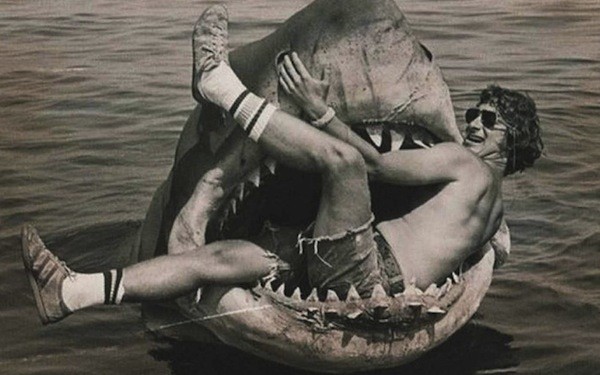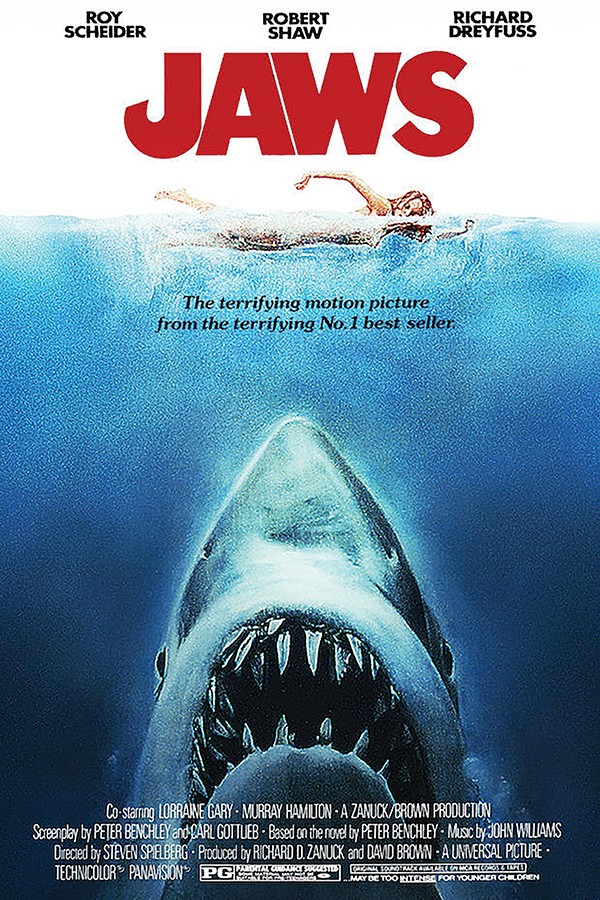
Francois Truffault as Claude LaCombe in Close Encounters of the Third Kind.
A fully restored, 4K version of Steven Spielberg’s 1977 classic Close Encounters of the Third Kind is currently in theaters to celebrate the 40th anniversary of its release. In this edition of Never Seen It, I took Memphis experimental filmmaker and Memphis Flyer contributor Ben Siler to see the film at the Malco Paradiso. It’s one of my desert island, all-time favorites, but it seems Ben and I had very different experiences at this screening.
Before Close Encounters:
Chris McCoy: What do you know about Close Encounters of the Third Kind?
Ben Siler: The song, mashed potatoes, beautiful UFOs at the end, Francois Truffaut is somewhere inside.
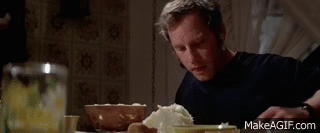
Afterwards, we retired to Whole Foods for lunch of chicken and mashed potatoes.
BS: It’s my knee jerk response to be critical about Spielberg.
CM: What’s your beef with Spielberg?
BS: Well, he’s schmaltzy, and he doesn’t know how to end a movie. He hasn’t for fifteen years. He’s a very skilled person, and great and wonderful, but I think he’s had enough praise, and it’s right to be skeptical of him. He’s not a wunderkind any more, I guess, so what he’s selling is a little more obvious. But this was a great film.
CM: So you just knew the highlight reel scenes, right? The infamous mashed potatoes, and the pretty spaceships at the end. What about the rest of it? Did it go where you thought it was going to go?
BS: It reminded me of Lost. J. J. Abrams was in the [retrospective documentary] short at the beginning. I loved the tension, and the buildup—basically, the globetrotting, finding the elements and putting them together to solve the mystery. I thought it was really nicely handled.
But again, I have a knee jerk thing against Spielberg. It all built up to the pretty lights and the schmaltz. Which is OK. I like different things to be emphasized when you’re dealing with the unknown and spirituality. It’s pretty spiritual and religious. It was a movie that, on my best day, I could dream about making maybe one frame of. But still, my favorite thing about that whole last sequence was Richard Dreyfuss kissing Melinda Dillon. That was tacky and kind of offensive and gross, and that’s what real life is like. It’s not hermetically sealed pretty lights that take you away out of your crappy 1970s marriage to Terri Garr. I feel like it needed more details like that, which was really a tone deaf thing put in there by Spielberg.
The movie is saying that you’ll transcend through your obsessions. I feel like Star Wars is much healthier when it comes to technology, and I’m not the first to say this. In that, technology is clunky and old, and you can bend it to your will to do amazing things. You can travel the universe, but it’s clunky and crappy and it’s old and you have to work with it to go really fast. In this, [Roy Neary’s] obsession is just this spiritual thing. He has this marriage that is really…loud. There are a lot of loud things in the foreground, throughout the entire movie. The TV is always on, and five different people are talking while they tell the story visually. There’s a lot of people speaking French and Hindi.
Again, I’m primed to pounce on him. But the message is, your obsession will save you, it will be transcendent, it will carry you away, and it will be beautiful. In my experience, that’s just not the case.
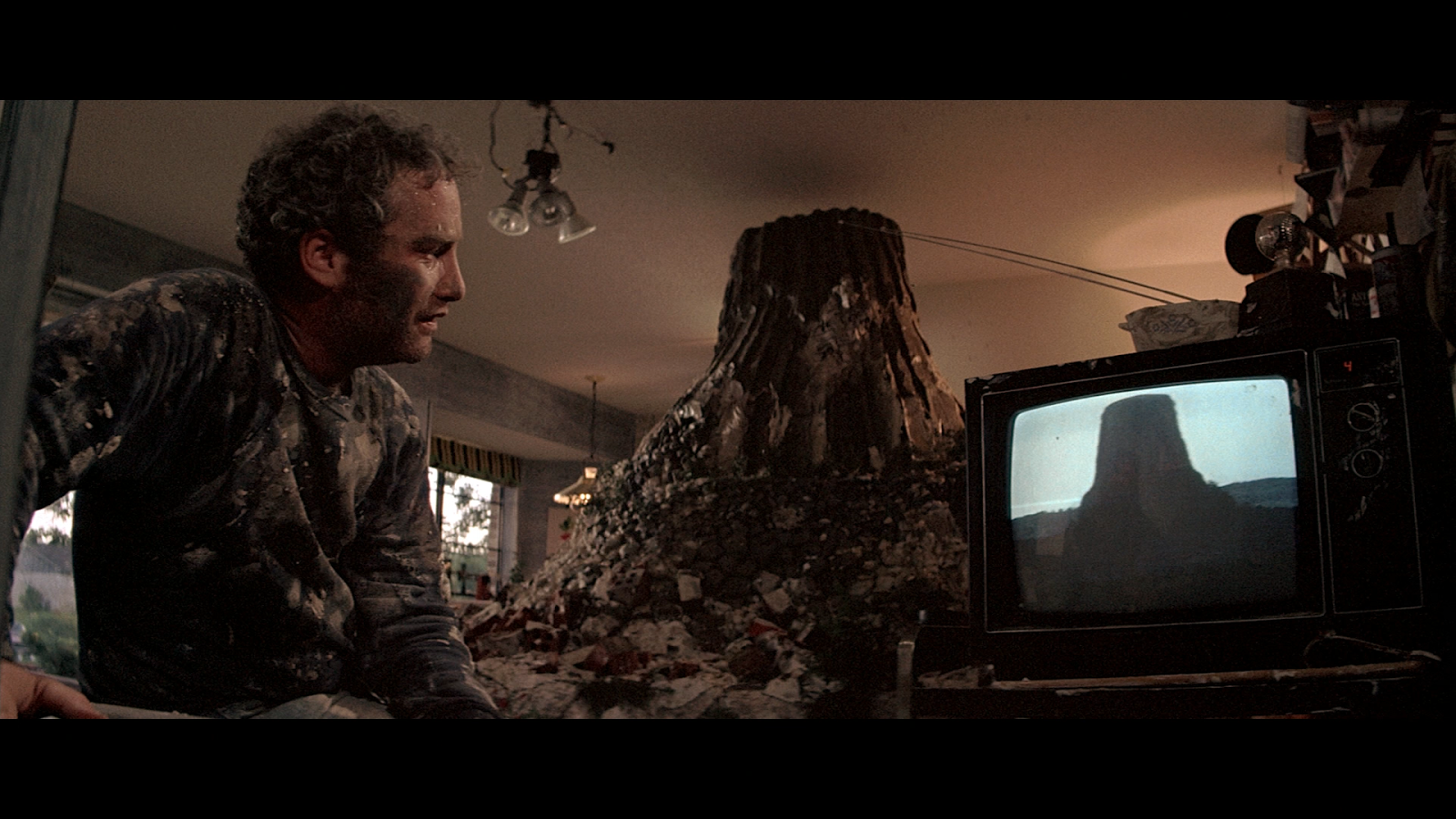
Richard Dreyfuss as Roy Neary, model maker.
I was most excited about Terri Garr and Richard Dreyfuss’ crappy marriage, and how unhappy it was. I like angry Terri Garr. I love Lost, and J. J. Abrams makes facsimiles of other people’s work. He made Super 8, which works for about 30 minutes, then it’s complete shit. This is what he was imitating. It’s a silver platter, a beautifully made film. I felt all of the emotions I was supposed to be feeling: Awe, wonderment, but tinged with horror.
I was just listening to a thing about those pilots who were lost in the Bermuda Triangle. Spielberg takes the unknown, and answers it with this quasi religious thing where they come back from the dead.

Bob Balaban finds Flight 19.
CM: I think you’re really onto it with the spiritual aspect. This is a non-religious, religious experience. That’s what this is about. Have you ever read Childhood’s End? It struck me this time that there’s a lot of Childhood’s End in Close Encounters. It’s a first contact story: What does first contact look like? Why is first contact with aliens even important? Why do we even care? It’s a transcendent, quasi-religious moment. Is there a sense that the aliens were going to come and solve everybody’s problems?
BS:That may be something I was adding into it.
CSM: They solved Roy Neary’s problems. But they also caused a lot of Roy Neary’s problems.
BS: They didn’t solve Mrs. Neary’s problems. They took away her husband.
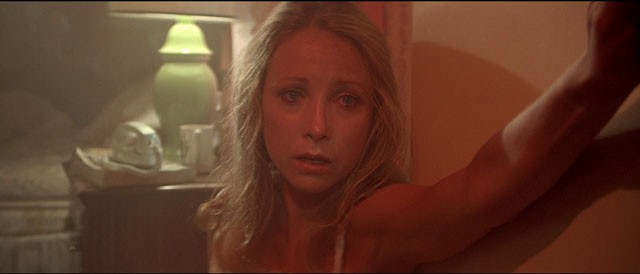
Terri Garr as Ronnie Neary.
CM: He was a pretty crappy husband, anyway. Spielberg said the only thing he regrets about this movie is that Roy Neary goes away with the aliens at the end and leaves his family. He said if he made it today, Roy Neary wouldn’t leave his family.
BS: I feel that would weaken it. He’s not interested in his family.
CM: I think the character also has to make a sacrifice to make what happens next meaningful. The sacrifice is his normality.
BS: You said first contact. I read this book about Captain Cook. It was just a long list of first contacts with people in the South Pacific. They were kind of interesting and fun. His main thing was, he would talk to people, and they would have a different concept of ownership than him. They would end up stealing one of his men’s canoes. Then he would go with a gun and an armed guard, find the chief of the town, and take him back to his ship and say, ‘You’ve got to return my canoe. Until then, I’m holding your chief hostage.’ That’s how he got killed. He tried that in Hawai’i, and someone brained him. That’s what first contacts are like. They’re not like, a spiritual transcendence. I looked at it through the lens of his marriage. She said they needed to go to couples’ therapy. Yeah, he should have gone to couple’s therapy.
CM: Terri Garr is fantastic in this.
BS: Old Terri Garr got angry. There’s a long interview in the AV Club where she says everyone she ever worked with was a sexist asshole. She names names…It’s refreshing to see elderly Terri Garr get angry about that. I thought their marriage was funny. I would like to see a movie about their failing marriage, and at the end, something unhappy happens. That would make me so much more excited. He has a marriage, for conditioned reasons, and three kids in Speilbergian suburbia. It’s not doing it for him. They don’t even like Pinocchio. I’m assuming because he’s a protagonist in a movie that he’s unhappy at first. Then he gets a new religion, which is, pretty lights in the sky, they’re special, and they’re special to him. I didn’t notice if the dudes in the red suits went off in the end. Did they just choose the obsessive nerd?
CM: Yes
BS: Only Richard Dreyfuss got to go off with the aliens in the end?
CM:He was the one they invited. If Melinda Dillon had been in the front row, they would have taken her, too. They were invited.
BS: Not a great use of Melinda Dillon, I thought. She’s much better in Christmas Story and Slap Shot, when she’s being sarcastic and mean. My favorite part with her was when her little boy was running away from her, and she was running after him. Your little boy is about to get run over! When she was the beleaguered housewife, that was better than her being sad all the time.
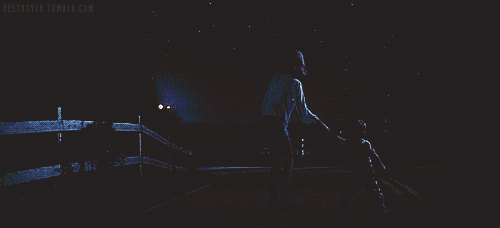
Spielberg was obsessed with film. He snuck onto the lot of Universal and he started making movies. His obsession rewarded him many times over. He’s a billionaire. I feel like, for most people, it’s not good advice to follow your dreams…
CM: Well that’s horrifying.
BS: …at least not at the expense of your children. Maybe I have a really big axe to grind with Spielberg.
CM:I think it doesn’t work if he doesn’t go with the aliens. The crying in the shower scene was cut from the 1977 version. It goes straight from the mashed potatoes to working on the model train set. He wakes up and sees his kid there, watching a Marvin the Martian cartoon, and decides this whole thing has been stupid. Then when he tries to tear down his Devil’s Tower model, his obsession is renewed. He goes on to build an even bigger and better Devil’s Tower model that leads to the end of his marriage.
But this version we saw had the crying in the shower scene. That’s the most intense family conflict part. I think it’s an entirely different movie with that scene in it. You see the effect of Roy’s obsession on his family.
BS: Well, the kid was crying with the mashed potatoes.
CM: Yeah, but when they’re screaming and banging the door, it’s really intense. It’s hard for me to watch.
BS: I really liked that part.
CM: So basically, you just want to see scenes from Roy and Ronnie’s marriage.
BS: It’s more what life is like. Inside the spaceship, it could be like “To Serve Man”. It could be a slaughterhouse in there.

Roy Neary is chosen by the aliens.
CM: It’s difficult to separate this from the 1970s. There was a huge interest in the paranormal. It was the second American UFO wave—the 1950s and the 1970s. I love it that the Air Force guy is actually telling the truth. People shot six billion pictures in 1977 and none of them had any aliens in them. One of my favorite lines from the Ferguson Era has been, “Before everybody was running around with cameras in their pockets, we thought that UFOs were real and there was no police brutality towards black people. But now that everyone’s carrying a camera, there are no UFOs, and there’s police brutality towards black people.”
There was a huge cultural obsession with all of that stuff: The Bermuda Triangle, Bigfoot, all of it…When the neighbor lady wakes up, she has a paperback on her chest that she had fallen asleep reading. That’s where all that stuff lived, in cheap paperbacks. People read a lot more, and cheap paperbacks about paranormal stuff was a huge industry. J. Alan Hynek, the guy with the goatee and the pipe who had an unexplained close up in the finale, was credited as technical advisor. He was selling millions of books about UFOs, and that’s what Spielberg was reading. The whole UFO myth is a redemption myth. They’re angels. My life is crap. Take me away. I think that’s what the UFO stuff in the 1970s was about, a longing for transcendence.
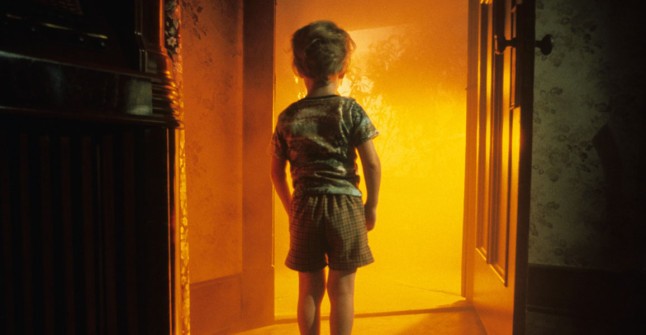
Carry Guffy as Barry, about to be taken away by the aliens.
BS: Spielberg said in the intro that this was inspired by Watergate. If there was a conspiracy to cover up Watergate, then there could be an even larger conspiracy to cover up aliens. I think that’s a strange lesson to take from Watergate.
I used to watch TV shows about aliens, and then I would have trouble sleeping at night. I remember one night, I saw a reflection in my window. It was probably my own reflection, but I interpreted it as possibly an alien. So I froze, slowly lowered the blinds, and backed away. I was terrified of shadows. You take the unknown, and it’s exciting. But there needs to be a messiness to it. That ending is really clean.
I really love this YouTuber…actually, I don’t love him…This guy has made a three hour documentary called Ancient Aliens Debunked. He’s an archeologist, and he takes every episode of Ancient Aliens and inserts his debunking of each and every single claim. One of the guys from the show is Erik von Däniken, who wrote Chariots of the Gods. I bought that book for 50 cents at Burke’s Books and tried to read it. I got like four pages into it. It was fucking terrible. Spielberg is a better writer and craftsman than Erik von Däniken, but he’s selling a similar story: Not that aliens helped build ancient civilizations, but that aliens are some sort of place to look to. What about Larry, the guy who got gassed and couldn’t see the aliens? Nobody in America got to see that stuff, just some self-appointed assholes in government had a transcendent moment. Everybody else got screwed.
CM: But that wasn’t the aliens’ intention. The aliens invited all these people. It was the government assholes who got in the way.
BS: There was only transcendence for one person. I find that lousy.

CM: That’s very interesting, because one of the things I love about Spielberg is that he makes almost Soviet movies. This is a movie about a mass movement of people, like Battleship Potemkin. There is no real single antagonist, a group is the antagonist—the government. Roy is the one that we follow, but there is a whole movement of people who saw the UFOs and want to meet them at Devil’s Tower. There are whole groups of people who do things, and that things happen to, in this movie. 1941 is the same way, and the first half of Jaws is like that, before they get on the boat. It’s about what happens to Amity, the beach town, not just to one or two people. American movies are much more individualistic than Soviet movies, but not how Spielberg makes them. Amistad is about a mass movement of people. A group of people is a single character.
BS: Yeah, but in War of the Worlds, the aliens are mean, and Tom Cruise is trying to connect with his son. When I was a little kid, I read Jurassic Park. I loved evil John Hammond in the book. I thought the addition of Alan Grant’s problems with kids and divorce had nothing to do with Jurassic Park. It was just cynically put in to sell tickets. It doesn’t matter if Jeff Goldblum is there to say stuff about lunch boxes.
I wanted to say, the Ancient Aliens Debunked show, in the end, it turns around and becomes a commercial for “The Bible is real!” The archeologist who put this on his YouTube channel literally thinks that giants and angels are making all this stuff. It’s insane. What’s so lovely about that is, you start off thinking this guy is skeptical about all this stuff, then he turns around a makes a ridiculous claim. He’s an unreliable narrator, and kinda crazy. That’s awesome. He also has a very calming voice, which is good to fall asleep to.
Never Seen It: Watching Close Encounters of the Third Kind with Filmmaker Ben Siler (2)
